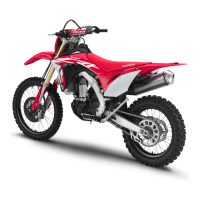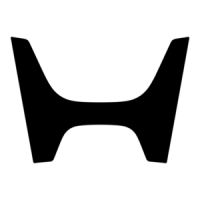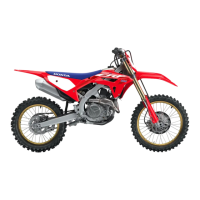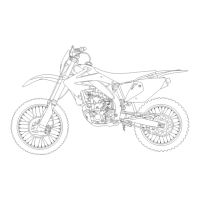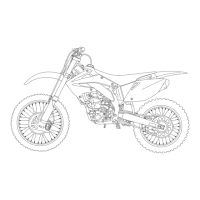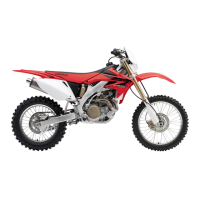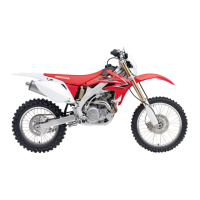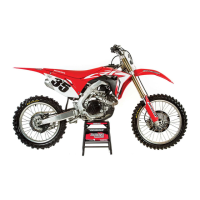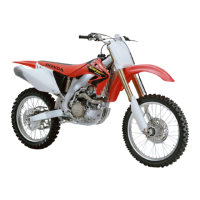
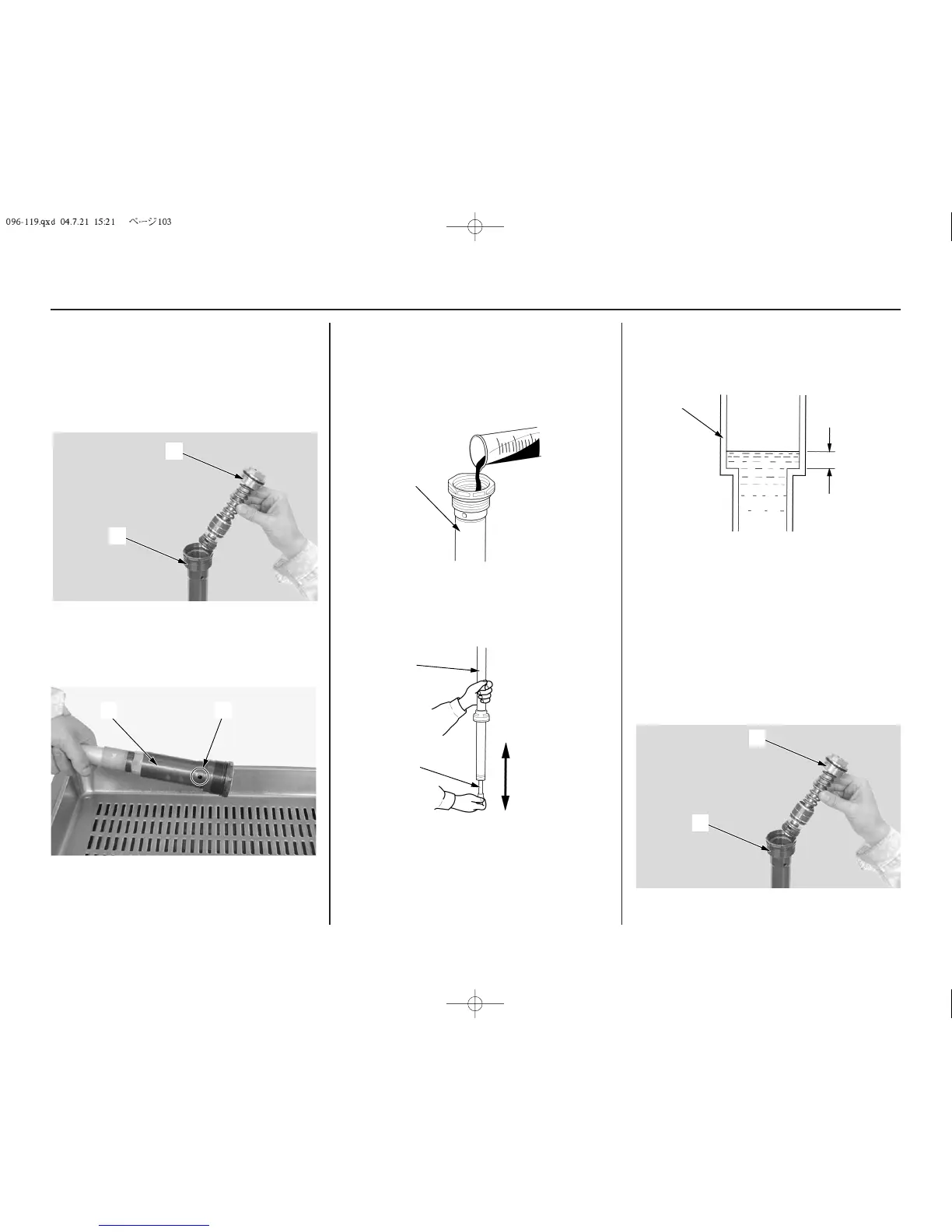 Loading...
Loading...
Do you have a question about the Honda CRF450R and is the answer not in the manual?
| Bore x Stroke | 96.0mm x 62.1mm |
|---|---|
| Compression Ratio | 13.5:1 |
| Fuel System | Programmed Fuel Injection (PGM-FI), 46mm throttle body |
| Ignition | Full transistorized ignition |
| Starter | Electric |
| Transmission | 5-speed |
| Front Suspension | 49mm inverted Showa coil-spring fork with rebound and compression damping adjustability; 12.2 inches travel |
| Front Brake | Single 260mm disc with twin-piston caliper |
| Rear Brake | Single 240mm disc |
| Front Tire | 80/100-21 |
| Rear Tire | 120/80-19 |
| Final Drive | Chain |
| Rear Suspension | Showa single shock with Pro-Link; rebound and compression damping adjustability; 12.4 inches travel |
Explains signal words DANGER, WARNING, CAUTION and their meanings.
Presents essential information and recommendations for safe riding.
Lists key precautions for safe operation, including gear and rider limits.
Warns against combining alcohol and riding due to impaired judgment.
Emphasizes proper maintenance for safety, citing loose parts as a hazard.
Warns that improper modifications can lead to crashes, serious injury, or death.
Identifies the location of basic controls on the CRF motorcycle.
Discusses evaluating riding readiness, including physical and mental condition.
Covers essential checks to ensure the motorcycle is ready for riding.
States that not wearing a helmet increases the risk of serious injury or death.
Details items to check before every ride for safety and performance.
Advises against operating the engine in enclosed areas due to carbon monoxide risk.
Provides instructions on how to start and stop the engine, including cold/warm engines.
Details how to break in the CRF for reliability and performance.
States the need to ensure the transmission is in neutral and the fuel valve is ON.
Details the step-by-step procedure for starting the engine.
Provides steps to clear a flooded engine if it fails to start.
Introduces topics like importance of maintenance, safety, and schedules.
Lists steps like component location, seat, fuel tank, and subframe removal.
Covers procedures for fluids, filters, engine, chassis, and appearance care.
Warns that improper maintenance can lead to crashes, serious injury, or death.
Lists key precautions for performing maintenance tasks safely.
Warns that failure to follow instructions can cause serious injury or death.
Explains notes and procedures (I, C, L, R) used in the maintenance schedule.
Refers to the pre-ride inspection section for items to check before competition.
Recommends standard spark plugs and warns against improper heat range.
Warns that improper heat range or reach can cause engine damage.
Details steps for removing, inspecting, and installing spark plugs.
Explains the importance of cleaning the air cleaner to prevent engine damage.
Stresses regular changes for transmission and clutch service life.
Advises on resealing the air cleaner housing boot to prevent dirt intrusion.
Provides basic cleaning steps for the motorcycle.
Details post-race procedures like lubrication and chain care.
Warns about the hazards of gasoline and safe handling practices.
Recommends unleaded fuel and specifies the required octane number.
Details the steps for safely opening the fuel cap and adding fuel.
Warns about the hazards of gasoline and safe handling practices.
Specifies recommended API classification, viscosity, and JASO standard for engine oil.
Provides steps for draining and replacing engine oil and the oil filter.
Warns that improper oil filter installation can cause serious engine damage.
Specifies recommended types of transmission oil and their properties.
Details the steps for draining and refilling the transmission oil.
Recommends Pro Honda HP coolant or equivalent and specifies distilled water use.
Explains how to check and add coolant to the cooling system.
Warns that removing the hot radiator cap can cause coolant spray and scalding.
Details inspection points for leaks, hoses, clamps, radiator, and water pump.
Recommends dealer service for coolant replacement unless qualified.
Warns against removing the hot radiator cap to prevent coolant spray.
Warns that wrong air cleaners cause premature engine damage.
States improper maintenance causes poor performance and premature engine wear.
Details the steps for cleaning the air cleaner assembly.
Explains how to drain deposits from the crankcase breather tube.
Describes how to inspect and adjust throttle freeplay.
Details how to adjust the engine idle speed using the throttle stop screw.
Explains how to adjust clutch lever freeplay using cable end and integral adjusters.
Details minor adjustments to clutch lever freeplay using the cable end adjuster.
Explains using the integral adjuster when cable end adjuster is at its limit.
Covers checks for lever assembly, cable condition, and lubrication.
Guides on checking for smooth operation and potential issues.
Describes how to inspect clutch discs for wear and measure their thickness.
Explains how to inspect clutch springs for free length and when to replace them.
Details steps for removing clutch components.
Explains how to inspect and adjust hot start lever freeplay.
Recommends standard spark plugs and warns against improper heat range.
Warns that improper heat range or reach can cause engine damage.
Details steps for removing, inspecting, and installing spark plugs.
Details steps for removing the cylinder head cover.
Explains how to position the piston at TDC for accurate valve clearance measurement.
Guides on measuring intake, exhaust, and decompressor arm valve clearances.
Details steps for removing the camshaft holder assembly.
Warns against dropping components into the crankcase during removal.
Explains how to measure shim thickness and calculate the correct replacement.
Warns against dropping components into the crankcase during installation.
Details steps for removing the cylinder head.
Warns against damaging the piston during pin removal.
Details how to remove the piston and piston pin clips.
Warns against dropping dowel pins and cam chain into the crankcase.
Warns against letting the cam chain fall into the crankcase.
Details how to remove the piston and piston pin clips.
Warns against damaging the piston during pin removal.
Warns against damaging piston rings by spreading them too far.
Details how to install the piston, paying attention to orientation and pin clips.
Stresses the importance of using new pin clips and not reusing old ones.
Outlines the process of installing the cylinder, gasket, and dowel pins.
Warns against letting dowel pins fall into the crankcase during installation.
Warns against damaging piston rings and cylinder walls during installation.
Details steps for installing the cylinder head, gasket, and related components.
Warns against letting dowel pins fall into the crankcase during installation.
Warns against letting washers and nuts fall into the crankcase during installation.
Warns against damaging piston rings and cylinder walls during installation.
Outlines checks for fork protectors, dust seals, wear rings, and overall operation.
Covers inspection of the shock absorber, spring, and swingarm bearings.
Lists recommended fork oil viscosity and types.
Details the steps for draining and refilling fork oil.
Warns that the outer tube can damage dust seals if not handled properly.
Lists fork oil capacities for different fork spring types.
Explains how air pressure affects fork action and how to release it.
Details how to adjust rebound and compression damping for standard settings.
Discusses fork spring rates and oil levels for adjusting performance.
Outlines steps for disassembling the front suspension.
Warns against using adjustable wrenches on fork dampers to prevent damage.
Warns against overtightening the vise when working on the axle holder.
Warns that improper brake hose routing can cause rupture and loss of braking efficiency.
Details how to check front and rear brake fluid levels and what to do if low.
Explains how to adjust the freeplay of the front brake lever.
Describes how to adjust the brake pedal height relative to the footpeg.
Explains how to inspect front and rear brake pads for wear and when to replace them.
Details inspection of rims and spokes, and how to tighten loose spokes.
Covers checking chain slack, wear, and lubrication.
Details how to adjust drive chain slack and tighten axle nuts.
Recommends specific lubricants for the drive chain.
Outlines steps for removing, cleaning, and replacing the drive chain.
Warns that new chains wear rapidly with worn sprockets.
Provides tips on master link security and installing new chains.
Guides on checking flange bolts, pipe joints, and for cracks or deformation.
Details steps for removing the muffler.
Describes the process of installing the muffler, clamp, and related parts.
Provides recommendations on cleaning products and avoiding damage.
Warns that high-pressure washing can damage motorcycle parts.
Advises on cleaning and removing stains from aluminum frame parts.
Warns against using steel wool on frames as it can cause damage.
Covers adjusting front suspension for rider and conditions.
Details adjusting rear suspension spring preload and damping.
Provides guidance on adjusting suspension for different track surfaces.
Offers general guidelines for adjusting suspension settings.
Explains how air pressure affects fork action and how to release it.
Details how to adjust rebound and compression damping.
Discusses fork spring rates and oil levels for adjusting performance.
Outlines steps for disassembling the front suspension.
Warns against using adjustable wrenches on fork dampers to prevent damage.
Warns against overtightening the vise when working on the axle holder.
Warns against bending or damaging the fork damper piston rod during stroking.
Warns that firm axle seating is needed when torquing pinch bolts to avoid damage.
Details how to adjust spring pre-load for desired handling and ride height.
Explains how to adjust high and low speed compression damping.
Details how to adjust high speed compression damping.
Details how to adjust low speed compression damping.
Explains how to adjust rebound damping.
Explains how to measure and adjust race sag for optimal competition handling.
Provides guidelines for adjusting front suspension based on track type and stiffness.
Identifies components of the cold start and hot start circuits.
Explains the functions of the Accelerator Pump, Slow, and Main circuits.
Explains how the accelerator pump circuit operates.
Details how the slow circuit meters fuel and air.
Explains how the main circuit meters fuel and air.
Explains the functions of the Accelerator Pump, Slow, and Main circuits.
Details adjustment of pilot screw for off-idle performance and jet size selection.
Outlines steps for removing the carburetor.
Warns about the hazards of gasoline and safe handling practices.
Guides on making minor adjustments to settings using tuning information.
Details the process for adjusting carburetor settings and verifying with a spark plug reading.
Warns about the hazards of gasoline and safe handling practices.
Provides jetting recommendations based on altitude and temperature.
Advises on main jet adjustments for specific track conditions like sand or uphill sections.
Lists checks to perform before adjusting carburetor settings.
Guides on making minor adjustments to settings using tuning information.
Details the process for adjusting carburetor settings and verifying with a spark plug reading.
Warns that improper heat range or reach can cause engine damage.
Warns that improperly tightened spark plugs can cause engine damage.
Suggests adjusting rear spring preload for traction and steering stability.
Explains how to adjust fork tube position for different wheels and handling.
Discusses adjusting wheelbase for improved turning response and stability.
Advises on positioning control levers for comfortable operation.
Guides on adjusting handlebar position, width, and shape for rider preference.
Provides guidelines for safely transporting the motorcycle.
Offers advice on preparing and storing the Honda for extended periods.
Gives tips on being an environmentally responsible motorcycle owner.
Outlines steps for cleaning, draining fuel, and lubricating before storage.
Warns about the hazards of gasoline and safe handling practices.
Details steps for preparing the Honda after it has been stored.
Warns that improper disposal of fluids harms the environment.
Explains how to identify the vehicle using frame and engine serial numbers.
Lists key dimensions, capacities, and specifications for the motorcycle.
Provides torque values for various nuts, bolts, and fasteners.
Warns that modified carburetors at low altitudes can cause overheating.
Warns that oxygenated fuels can damage paint and plastic surfaces.
Stresses recording settings and adjustments for track conditions, altitude, and temperature.
Encourages recording placings, thoughts for improvement, and strategy notes.
Lists regular maintenance items and component inspections to record.
Suggests recording race placings, performance thoughts, and competitor strategies.
Lists essential spare parts to carry for riding events.
Lists additional spares like brake components, wheels, and ignition parts.
Lists common tools needed for maintenance and repairs.
Lists specific Honda special tools required for certain procedures.
Lists recommended chemical products for maintenance and cleaning.
Provides information on obtaining official Honda service and owner's manuals.
Gives information on how to contact Honda for questions or feedback.
Advises on familiarizing oneself with the Honda dealer's services.
Highlights common causes of costly engine repairs and proper maintenance.
